The Material Culture of Seventeenth- and Eighteenth-Century Dutch Dollhouses: Replication, Reproduction & Imitation
Abstract
1. Introduction
2. Descriptions of Dutch Dollhouses in Primary Sources
All the known catalogues single out individual items as well as compile lists that draw a picture of diverse surfaces, borne out in views of the interior spaces. The second-floor lying-in bedroom, or kraamkamer from Petronella Oortman’s dollhouse is paneled in velvet, with silk hangings, silver wall sconces, linens, tortoiseshell mirrors, and a blue and white porcelain tea service (Catalogus 1798, p. 9; Figure 9). The catalogues mention, for example, the various types of wood used in the dollhouses (olive wood, walnut, ebony, teakwood, etc.), as well as different metals, and textiles. Petronella Oortman’s cabinet is identified as olive wood, with embellishments in teak, tortoiseshell, mirrors, pewter, copper, gold, and silver.…together in eleven rooms, and all thereof rooms beautifully divided and furnished, with infinite ornament and artefacts, oriental and Chinese porcelain dishes, bowls, bottles, tea pots, coffee jugs, coffee cups, cuspidors, Cups and Dishes, &c. all of which are impossible or too long to specify because of the multitude of hundreds of trifles
The dollhouse as it compares to the full-scale object it replicates creates a sense of authenticity that is primarily forged through materials. Perceptions of faithfulness in form and materials bolstered the reputation of the dollhouses as a marvel that represented the home accurately in every way. While the catalogue claims that “each piece of furniture, etc., has its complete identity,” it was, in fact, common to use different materials to create miniatures in the dollhouse that did not always correspond to the same construction found in full-scale furnishings. The use of imitative materials, however, was often executed in ways that maintained the illusion of accuracy to the original form it copied. One example where material substitutions were obvious (intentionally so) was the use of silver to create household objects in miniature, even seemingly insignificant things such as the previously noted fire tongs or cleaning implements (Figure 4 and Figure 5).Furthermore, that each piece of furniture, etc., has its complete identity, not only in material, but that which is to be nailed, is nailed, on that which is glued, it is glued; the hewn, hewed; cast; cast; forged, forged; and all this in its full parts, joints, seams, etc.: as a large piece, is always found. More order has been used in this art cabinet (Konst-Kasse) than in any imitated one, because almost everything, in contradiction to nature, in order to give quality, luster, is seen to be made of silver: but here, silver is what people are used to in these households. Silver, and so on, copper decorations are copper; Tin, Tin; Iron, Iron; the wood, of wood; Stone, Stone: and so on, nothing excepted; which, as can be understood, provides a pleasant view, as an example
3. Replication, Reproduction & Materials in the Dutch Dollhouse
4. Imitations and Material Goods in Dutch Dollhouse Cabinets
We can examine the dollhouses as grandly conceptualized imitations presented through miniaturization, a form that negotiates an Early Modern understanding of Smith’s market-driven idea, intertwined with Addison’s aesthetic theory. These ingredients also contribute to the idea of novelty which, as a frame for the reception of material goods, functioned to stimulate interest and desire. East Asian design through porcelain as one example is a fruitful part of period conversation about imitations that can also encompass the dollhouses. Porcelain, like the dollhouses, enfold multiple versions of imitations as copied commercial goods alongside crafted small-scale dollhouse furnishings. Imitation as an economic strategy, often in gendered contexts, is a lively but little-studied corner of discourse from the period between some of the most important economic theorists of the day. Smith saw imitation and innovation as dual engines that were buttressed by aesthetic theory. The crafted object, for example, had appeal for the consumer because its newness and remarkable nature stimulated pleasure and a desire for acquisition.Every thing that is new or uncommon raises a Pleasure in the Imagination, because it fills the Soul with an agreeable Surprise, gratifies its Curiosity, and gives it an Idea of which it was not before possest [sic]…whatever is new or uncommon contributes a little to vary human Life, and to divert our Minds, for a while, with the Strangeness of its Appearance: …It is this that recommends Variety, where the Mind is every Instant called off to something new.
By rendering a carpet in paint, using illusionism or dramatic lighting, the object is lifted to the realm of innovation, inciting closer examination through its representation in the visual arts.A painted cloth, the work of some laborious Dutch artist, so curiously shaded and coloured as to represent the pile and softness of a woolen one, might derive some merit from its resemblance even to the sorry carpet which now lies before me…the imitation frequently pleases, though the original object be indifferent, or even offensive…A butcher’s-stall, or a kitchen-dresser, with the objects which they commonly present, are not certainly the happiest subjects, even for Painting. They have, however, been represented with so much care and success by some Dutch masters, that it is impossible to view the picture [representation] without some degree of pleasure.
5. Imitation, Novelty and the Dollhouse Cabinet as Wonder
Beyond the catalogues, other records capture a different dimension of the contemporary response to the dollhouses as a wondrous collection. German collector and scholar Zacharias Von Uffenbach visited a number of collections in England, Germany and the Netherlands in the early decades of the eighteenth century, including the dollhouse of Petronella Oortman (in 1718, at that time belonging to her daughter Hendrina Brandt). Von Uffenbach’s commentary from these trips illuminates an understanding of how collections were explored and received at the time, as he was an experienced viewer of cabinet collections and voiced a decisive opinion on most everything he saw.means to make an object of one kind resembling another object of a very different kind; and to the original beauty of figure to join the relative beauty of imitation: but the disparity between the imitating and the imitated object is the foundation of the beauty of the imitation. It is because the one object does not naturally resemble the other, that we are so much pleased with it, when by art it is made to do so.
6. Conclusions: Imitation, Materials and Materiality
Funding
Institutional Review Board Statement
Informed Consent Statement
Data Availability Statement
Conflicts of Interest
| 1 | With thanks to the anonymous reviewers for their helpful comments. This study of pronk poppenhuisen takes cues from larger issues touched on in the forthcoming monograph, Michelle Moseley-Christian, At Home in the Early Modern Dutch Dollhouse: Gender, Materiality, and Collecting in the Seventeenth-and Eighteenth-century Netherlands (Amsterdam University Press). |
| 2 | New observations about the class and financial situation in which dollhouses were assembled are explored in At Home in the Early Modern Dutch Dollhouse. |
| 3 | From Catalogus van een overheerlijk kabinet, verbeeldende, een huyshouding in ‘t kleyn, so als zulks, ten volleedigsten souden kunnen worden vertoond: “…Bestaande in vyftien verdeelingen, alle zeer konstig en kostbaar, met allerhande meubilaire goederen vercierd, in een volmaakte proportie der huys-cieraaden, konststukken, schilderyen en rariteyten…” (Catalogus 1750) |
| 4 | “Bestaande in Elf Vertrekken, all zeer konstig en kostelyk met allerhande Meubelaire Goederen van binnen versiert in ‘t kleyn, zoo als ‘t in’t groot op zyn heerlykste zoude kunnen vertoont werden, in een volmaakte verdeeling van Huyscieraden en Rariteyten…” (Catalogus 1750) |
| 5 | “Bestaande, in eene Konst-Kasse in negen onderscheyde verdeelingen afgeberkt; verbeeldende in zyn geheel, den ganschen omslag van een proper, ordentelyk en welgeschikt Huishouden, waar van den Niuwsgierigen in’t beschryven van yder vertrek, ten naasten by; een kleyn denkbeeldt zal gegeven werden.” (Catalogus 1798) |
| 6 | “Bestaande al zoo te zaamen in elf Vertrekken, en alle derzelver Vertrekken op’t heerlykst verdeeld en gemeublieert, met oneindige Cieraden en Konstelykheden, Orientaalse en Chineese Porcelynen van Schotelwerk, Kommen, Flessen, Thée-Potten, Koffy-Kannen, Koonvoor, Quispedooren, Kopjes en Schootels, &c. welke alle om de meenigte van honderderhande kleinig-heden onmooglyk, of te lang om te specificeeren zyn.” (Catalogus 1758) |
| 7 | Catalogus van het wydvermaarde en alom bekende koninglyk kabinet, zynde een poppe-kas […]: “Voorts, dat yder Meubil enz: heeft zyne volslagene eygenschap, niet alleen in stof, maar, ‘t geen gespykert moet weezen, is gespykerdt ‘t gelymde, gelmyde; ‘t gehouwen, gehouwern; gegoten;gegoten; gesmeedt, gesmeedt; en dit alles in zyne volle deelen, leeden, voegingen naden enz: als stuk in het groot, immer wordt gevonden. Zynde in deeze Konst-Kasse meerder ordeel gebruykt als in eenige nagebootste, daar men byna alles, strydig tegen de Natuurlykheyt, om quanswys, luyster te geven van zilver ziet: doch hier, is zilver, ‘t geen men in destige Huishoudingen gewoon is van zilver te zien, en zoo vervolgens, Koopre Huyscieraaden Kooper; Tin, Tin; Yzer, Yzer; de Hout, van Hout; Steene, Steen: en zo verder niets uytgezondert; ‘t geen, gelyk te begrypen is, een aangename be schouwing geeft, als by voorbeeldt.” (Catalogus 1758). |
| 8 | “…sentire, quando veggiamo venire in concorrenza due di forze eguali, ò fra quale non sapiamo conoscere molta differenza…” From Secondo Lancellotti, L’Hoggidi overo il mondo non peggiore ne piit calamitoso del passato (Venice: Giovanni Guerigli, 1630 edition), 11. Translated in Loh (2004, p. 478). |
| 9 | “Löffeln undt gabeln von Silber, das Spitzen küßen von schildkrott war sehr curieux. Vor allen aber ist zumercken das feinest-Indische Porcellan, Welches expresse zu dießem Cabinet in Ost-Indien nachdem die modell dahin geschickt worden auf das Subtilste gemachte wordten.” |
| 10 | Transcribed in ter Molen (2017, pp. 265–70) from Von Uffenbach’s hand-written diaries in Niedersächsische Staats-und Universitätsbibliothek (SUB) Gottingen, Uffenb. Ms 46. |
| 11 | Swan has connected ebony to the enslaved labor that produced these articles. |
References
- Addison, Joseph. 1712. Spectator. No. 412. London, June 12. [Google Scholar]
- Baer, Ronni. 2015. Class Distinctions Dutch Painting in the Age of Rembrandt and Vermeer. Translated by Diane Webb. Boston: Museum of Fine Arts, MFA Publications. [Google Scholar]
- Berg, Maxine. 2005. Luxury and Pleasure in Eighteenth-Century Britain. Oxford: Oxford University Press. [Google Scholar]
- Black, Scott. 2001. Addison’s Aesthetics of Novelty. Studies in Eighteenth-Century Culture 30: 269–88. [Google Scholar] [CrossRef]
- Brewer, John, and Roy Porter. 1993. Introduction. In Consumption and the World of Goods. Edited by John Brewer and Roy Porter. London: Routledge, pp. 1–15. [Google Scholar]
- Catalogus. 1750. Catalogus van een Overheerlijk Kabinet, Verbeeldende, een Huyshouding in ‘t Kleyn, so als Zulks, Ten Volleedigsten Souden Kunnen Worden Vertoond…. Amsterdam. [Google Scholar]
- Catalogus. 1758. Catalogus van het Wydvermaarde en Alom Bekende Koninglyk Kabinet, Zynde een Poppe-Kas by een Vergadert door een Voorname Juffrouw en Wyders in Eygendom Bekomen, en Rykelyk Vermeerdert en Verbetert door Pieter van der Beek […]. Amsterdam. [Google Scholar]
- Catalogus. 1798. Beschryving van een Uytmuntendt Konst-Werk. Van ‘t Welk naar alle Vermoeden in Gansch Europa, Noch Elders eene Weêrga zal Kunnen Aangetoond Worden: Waar aan Ruim Vijf en Twintig Jaaren, Met Ongelooflyke Moeyte, Vlyt, en Verbaazende Kosten gear Beydt Is Catalogus van het Wydvermaarde en Alom Bekende Koninglyk Kabinet, zynde een Poppe-Kas. Amsterdam. [Google Scholar]
- De Groot, Julie. 2022. At Home in Renaissance Bruges: Connecting Objects, People And Domestic Spaces in a Sixteenth-Century City. Leuven: Leuven University Press. [Google Scholar]
- De Marchi, Neil. 2006. Smith on Ingenuity, Pleasure and the Imitative Arts. In The Cambridge Companion to Adam Smith. Edited by Knud Haakonssen. Cambridge: Cambridge University Press, pp. 136–57. [Google Scholar]
- Dibbits, Hester C. 1998. Vetrouwd Bezit: Matieriële Cultuur in Doesburg en Maassluis 1650–1800. Ph.D. dissertation, University of Amsterdam, Amsterdam, The Netherlands. [Google Scholar]
- Endlich, John. 2011. Nederlandse Zilveren Miniaturen uit de 17de en 18de eeuw, exh. Cat. The Hague: Gemeentemuseum. Zwolle: W-Books Zwolle. [Google Scholar]
- Fock, C. Willemijn. 2001a. Semblance or Reality? The Domestic Interior in Seventeenth Century Dutch Genre Painting. In Art and Home: Dutch Interiors in the Age of Rembrandt. Edited by Mariët Westermann. Denver: Denver Art Museum, pp. 83–101. [Google Scholar]
- Fock, C. Willemijn, ed. 2001b. Het Nederlandse Interieur in Beeld 1600–1900. Zwolle: Waanders. [Google Scholar]
- Gerritsen, Anne. 2016. Domesticating Goods from Overseas: Global Material Culture in the Early Modern Netherlands. Journal of Design History 29: 228–44. [Google Scholar] [CrossRef]
- Gerritsen, Anne, and Giorgio Riello. 2016. The Global Lives of Things: The Material Culture of Connections in the Early Modern World, 1st ed. London: Routledge. [Google Scholar]
- Grootenboer, Hanneke. 2021. Thinking with Shells in Petronella Oortman’s Dollhouse. In Conchophilia: Shells, Art, and Curiosity in Early Modern Europe. Edited by Marisa Anne Bass, Anne Goldgar, Hanneke Grootenboer and Claudia Swan. Princeton: Princeton University Press, pp. 103–23. [Google Scholar]
- Harris, Courtney. 2023. Tiny Treasures: The Magic of Miniatures. Boston: MFA Publications. [Google Scholar]
- Hollander, Martha. 2002. An Entrance for the Eyes: Space and Meaning in Seventeenth-Century Dutch Art. Berkeley: University of California Press. [Google Scholar]
- Honig, Elizabeth. 1997. The Space of Gender in Seventeenth-Century Dutch Painting. In Looking at Seventeenth-Century Dutch Art: Realism Reconsidered. Edited by Wayne Franits. Cambridge: Cambridge University Press, pp. 187–201. [Google Scholar]
- Jardine, Lisa. 1996. Worldly Goods: A New History of the Renaissance. New York: Nan A. Talese. [Google Scholar]
- Kareem, Sarah Tindal. 2014. Eighteenth-Century Fiction and the Reinvention of Wonder. Oxford: University of Oxford Press. [Google Scholar]
- Krauss, Rosalind. 1981. The Originality of the Avant-Garde: A Postmodernist Repetition. October 18: 47–66. [Google Scholar] [CrossRef]
- Loh, Maria H. 2004. New and Improved: Repetition as Originality in Italian Baroque Practice and Theory. The Art Bulletin 86: 477–504. [Google Scholar] [CrossRef]
- Loughman, John, and John Michael Montias. 2000. Public and Private Spaces: Works of Art in Seventeenth-Century Dutch Houses. Zwolle: Waanders. [Google Scholar]
- Malek, James S. 1972. Adam Smith’s Contribution to Eighteenth-Century British Aesthetics. The Journal of Aesthetics and Art Criticism 31: 49–54. [Google Scholar] [CrossRef]
- Moseley-Christian, Michelle. 2010. Pronk Poppenhuizen: Seventeenth-Century Didactic Dutch Dollhouses for Women. Home Cultures Interdisciplinary Journal 7: 41–64. [Google Scholar]
- Moseley-Christian, Michelle. 2014. Consuming Excess: Pronk Poppenhuizen and the Dollhouses of Sara Rothé. In The Uses of Excess in Visual and Material Culture, 1700–2010. Edited by Julia Skelly. Burlington: Ashgate Press, pp. 63–88. [Google Scholar]
- Nakamura, Jun P. 2020. Small worlds: The miniature logic of the seventeenth-century Dutch dollhouse. In Arts in Society Academic Rhapsodies. Leiden: Leiden University Centre for the Arts in Society, pp. 5–20. [Google Scholar]
- Nijboer, Harm. 2007. Een product ‘Tot oogen lust en pronkery’: De markt voor Hollandse Porselein. In Pretty Dutch: 18de-eeuws Hollands porselein. Edited by Ank Trumpie. Rotterdam: Museum Princessehof & 010 Publishers, pp. 22–25. [Google Scholar]
- Noorman, Judith. 2024. Household heroines: Maria van Nesse’s memory-book and the interplay between the art market and household consumption. Nederlands Kunsthistorisch Jaarboek 74: 106–33. [Google Scholar] [CrossRef]
- Noorman, Judith, Thijs Weststeijn, and Elizabeth Alice Honig. 2024. Women in the word of Netherlandish Art. In Women. Female Roles in Art and Society of the Netherlands, 1500–1950. Edited by Judith Noorman, Thijs Weststeijn and Elizabeth Alice Honig. Netherlands Yearbook for History of Art 74-1. Leiden: Brill, pp. 6–39. [Google Scholar]
- Odell, Dawn. 2018. Delftware and the Domestication of Chinese Porcelain. In EurAsian Matters. Transcultural Research—Heidelberg Studies on Asia and Europe in a Global Context. Edited by Anna Grasskam and Monica Juneja. Cham: Springer, pp. 175–202. [Google Scholar]
- Pijzel-Dommisse, Jet. 2000. Het Hollandse Pronkpoppenhuis: Interieur en Huishouden in de 17de en 18de eeuw. Amsterdam: Rijksmuseum. [Google Scholar]
- “Reflections on Novelty”. 1787, In The New Annual Register of General Repository of History, Politics, and Literature for the Year 1786. London: G.G.J. and J. Robinson.
- Rothé Ploos van Amstel, Sara. 1745. Notitieboekje met Stoffenomslag Behorend bij Poppenhuis. The Hague: Kunstmuseum Den Haag, No. 1034172. [Google Scholar]
- Schama, Simon. 1987. The Embarrassment of Riches: An Interpretation of Dutch Culture in the Golden Age. London: Collins. [Google Scholar]
- Smith, Adam. 1759. Theory of Moral Sentiments IV. London: Millar. [Google Scholar]
- Smith, Adam. 1795. Essays on Philosophical Subjects. London: Cadell and Davies. [Google Scholar]
- Smith, Adam. 1872. Essays. London: Alex. Murray & Co. [Google Scholar]
- Smith, Adam. 1880. Essays, Philosophical and Literary, 6th ed. London: Ward, Lock. [Google Scholar]
- Stewart, Susan. 1993. On Longing: Narratives of the Miniature, the Gigantic, the Souvenir, the Collection. Durham: Duke University Press. [Google Scholar]
- Stobart, Jon. 2020. Introduction. In The Comforts of Home in Western Europe, 1700–1900. Edited by Jon Stobart. London: Bloomsbury Academic, pp. 1–16. [Google Scholar]
- Swan, Claudia. 2024. Making a Case for Ebony. Journal of Early Modern History 28: 522–32. [Google Scholar] [CrossRef]
- TEFAF. 2017. TEFAF Maastricht, March 10-19-2017. Ghent: Graphius-DeckerSnoeck. [Google Scholar]
- ter Molen, Johan R. 1994. Een bezichtignig van het poppenhuis van Petronella Brandt-Oortman in de zomer van 1718. Bulletin van het Rijksmuseum 42: 120–36. [Google Scholar] [CrossRef]
- ter Molen, Johan R. 2017. Een Plezierreis in de Zomer van 1718: De Familie von Uffenbach in de Nederlanden. Zwolle: Waanders. [Google Scholar]
- Thorpe, Clarence DeWitt. 1937. Addison and Some of His Predecessors on ‘Novelty’. PMLA 52: 1114–29. [Google Scholar] [CrossRef]
- van Eeghen, Isabella H. 1953. Twee Poppenhuizen van Sara Rothé, huisvrouw van Jacob Ploos van Amstel. Maandblad Amstelodamum 40: 106–11. [Google Scholar]
- Westermann, Mariët. 2000. ‘Wooncultuur’ in the Netherlands: A Historiography in Progress. Nederlands Kunsthistorisch Jaarboek 51: 6–33. [Google Scholar] [CrossRef]
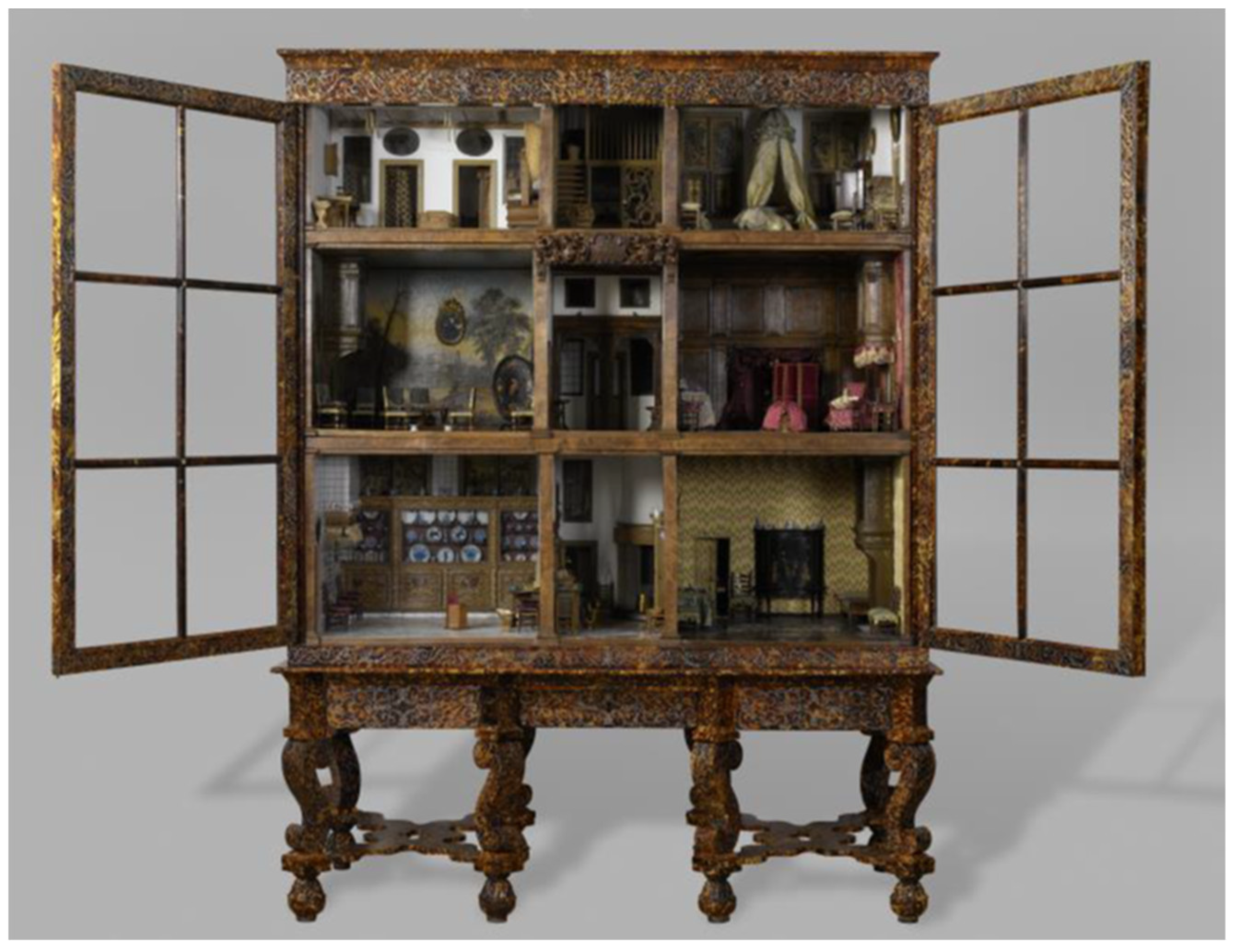
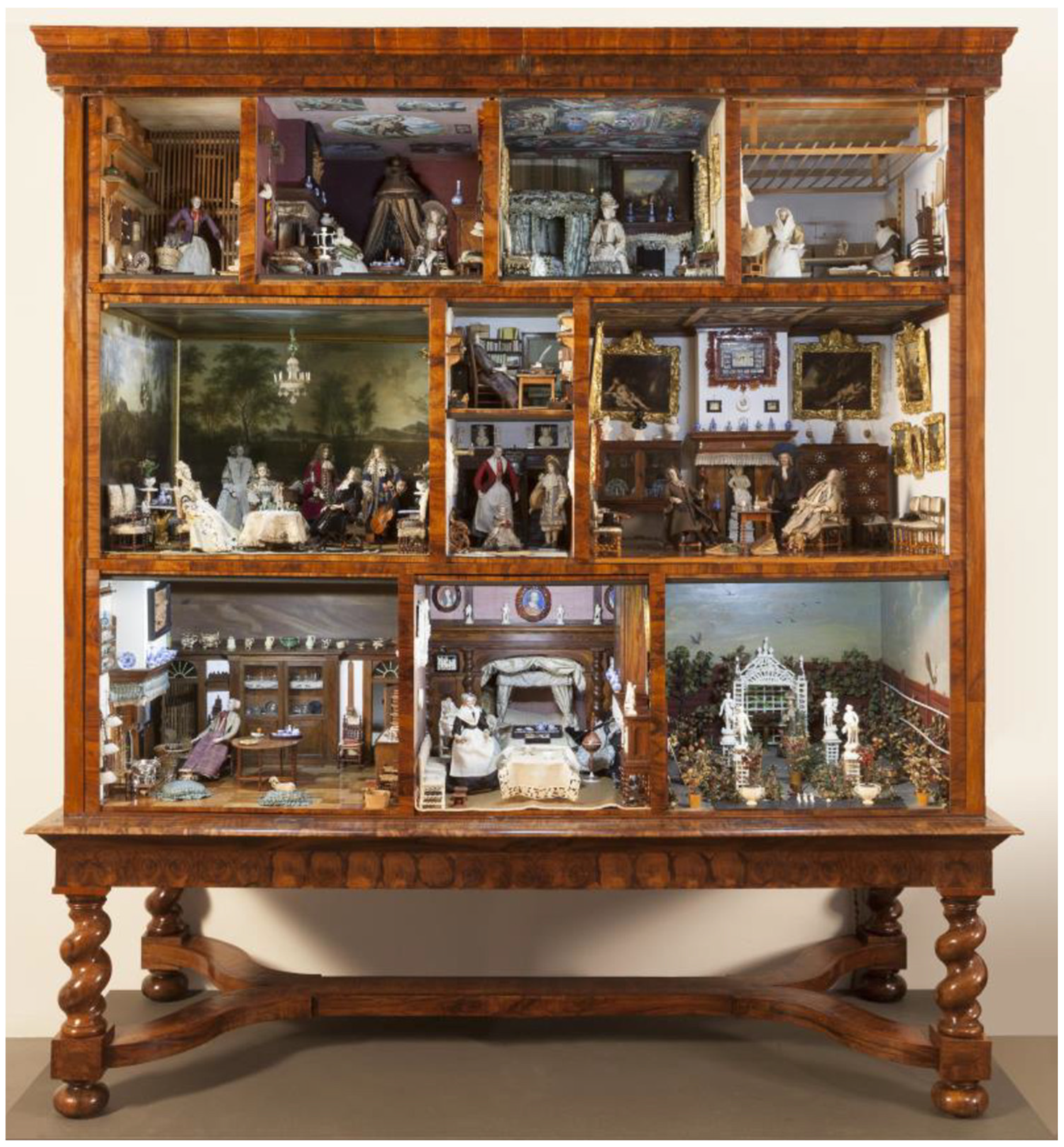
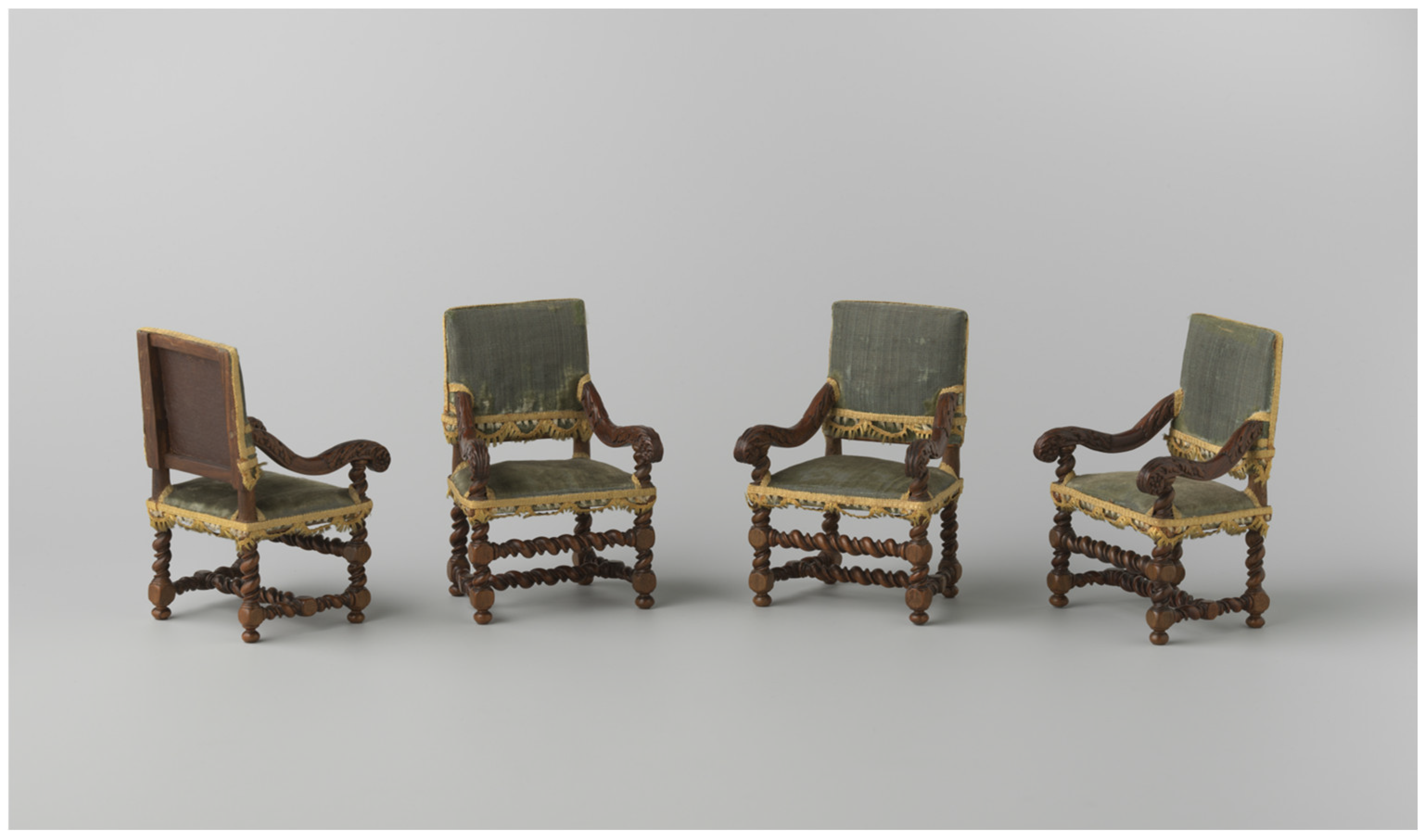



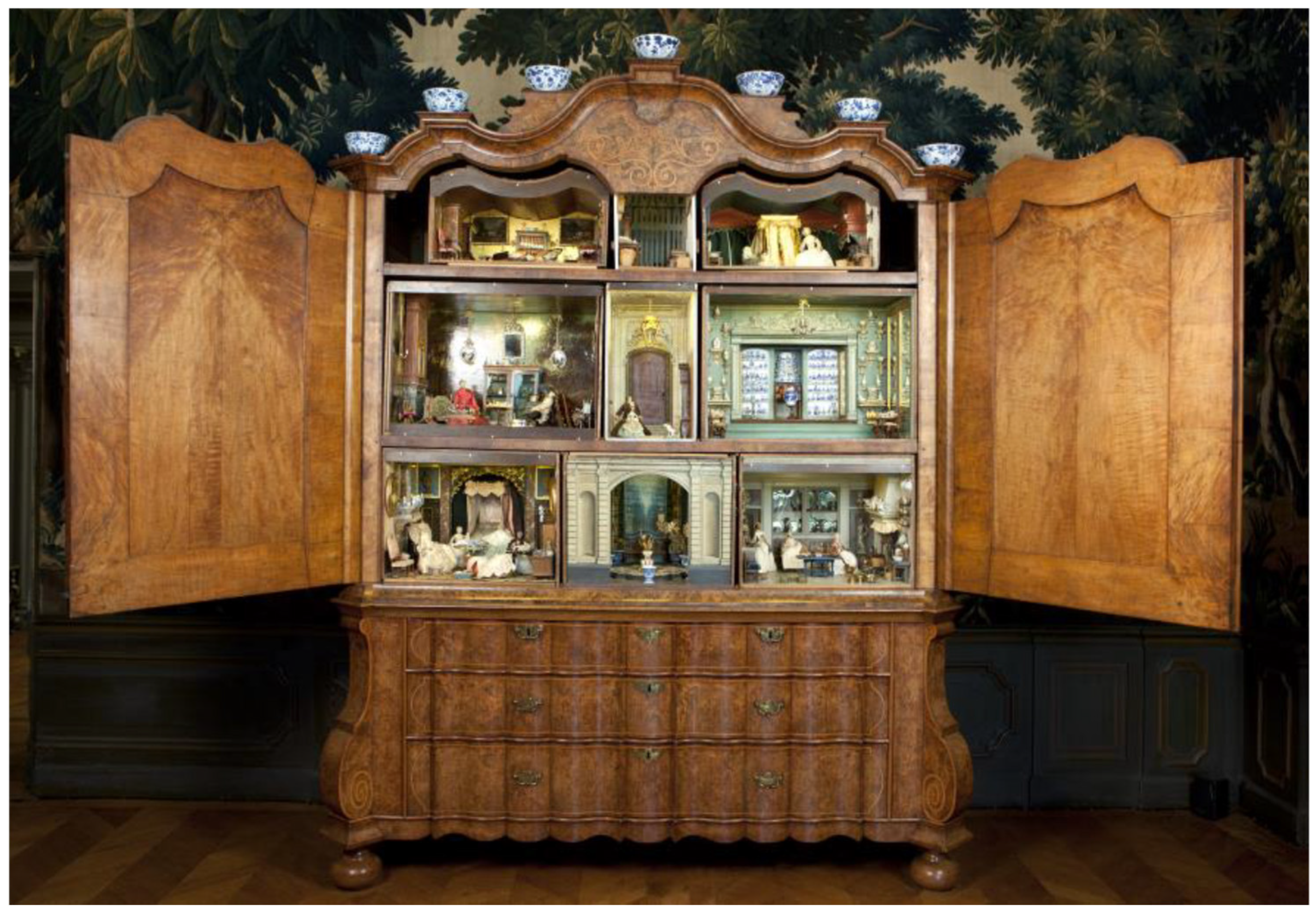

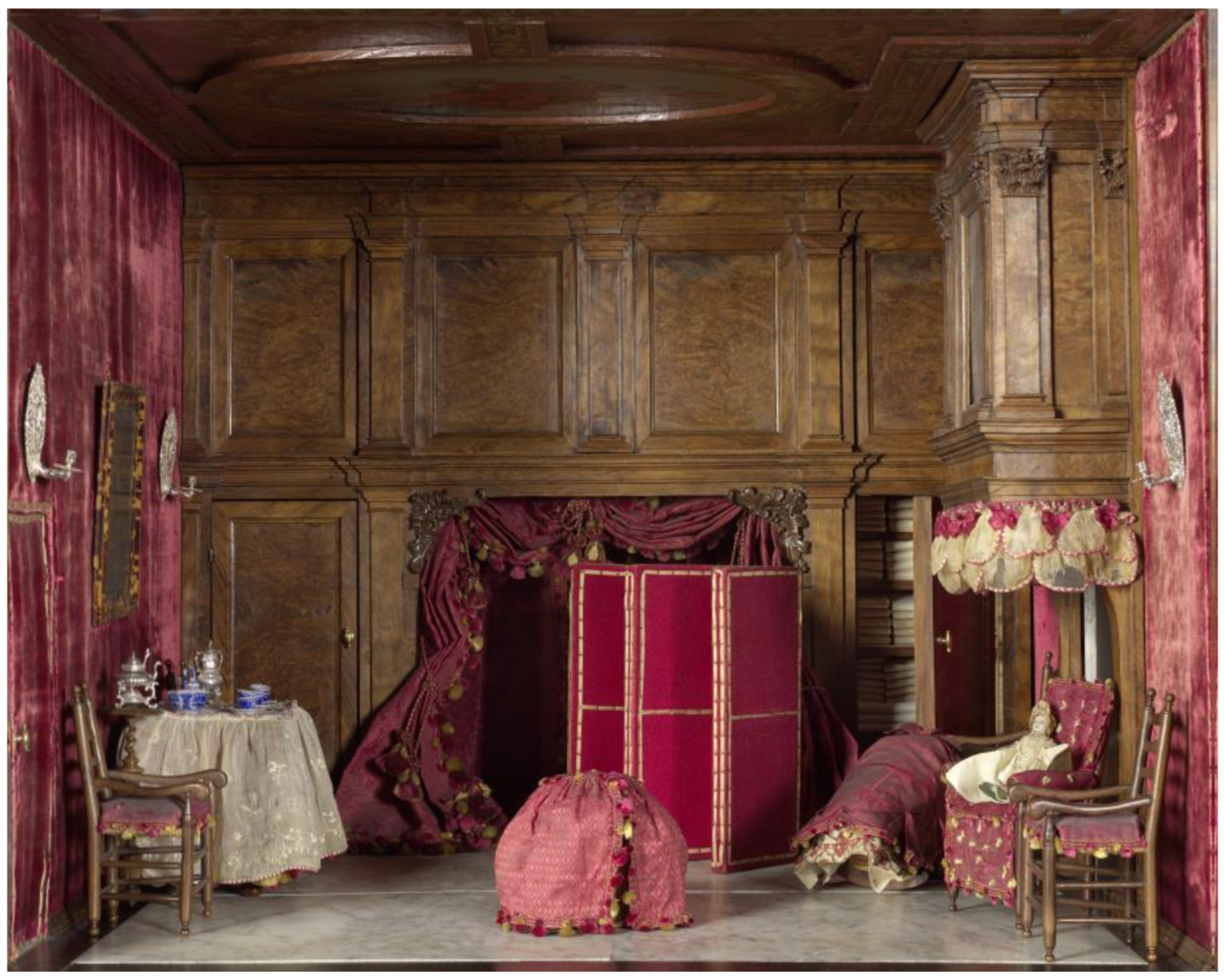


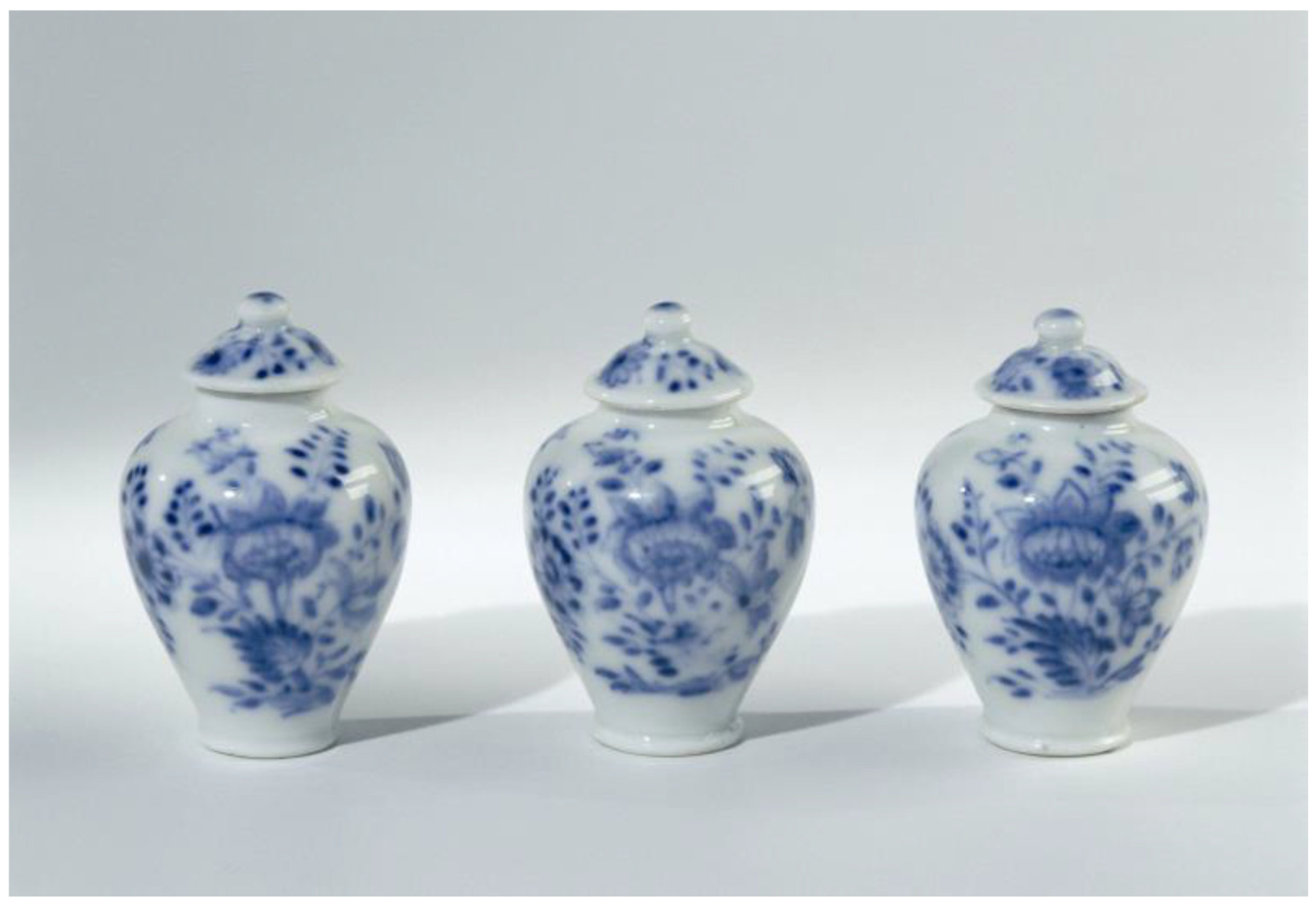


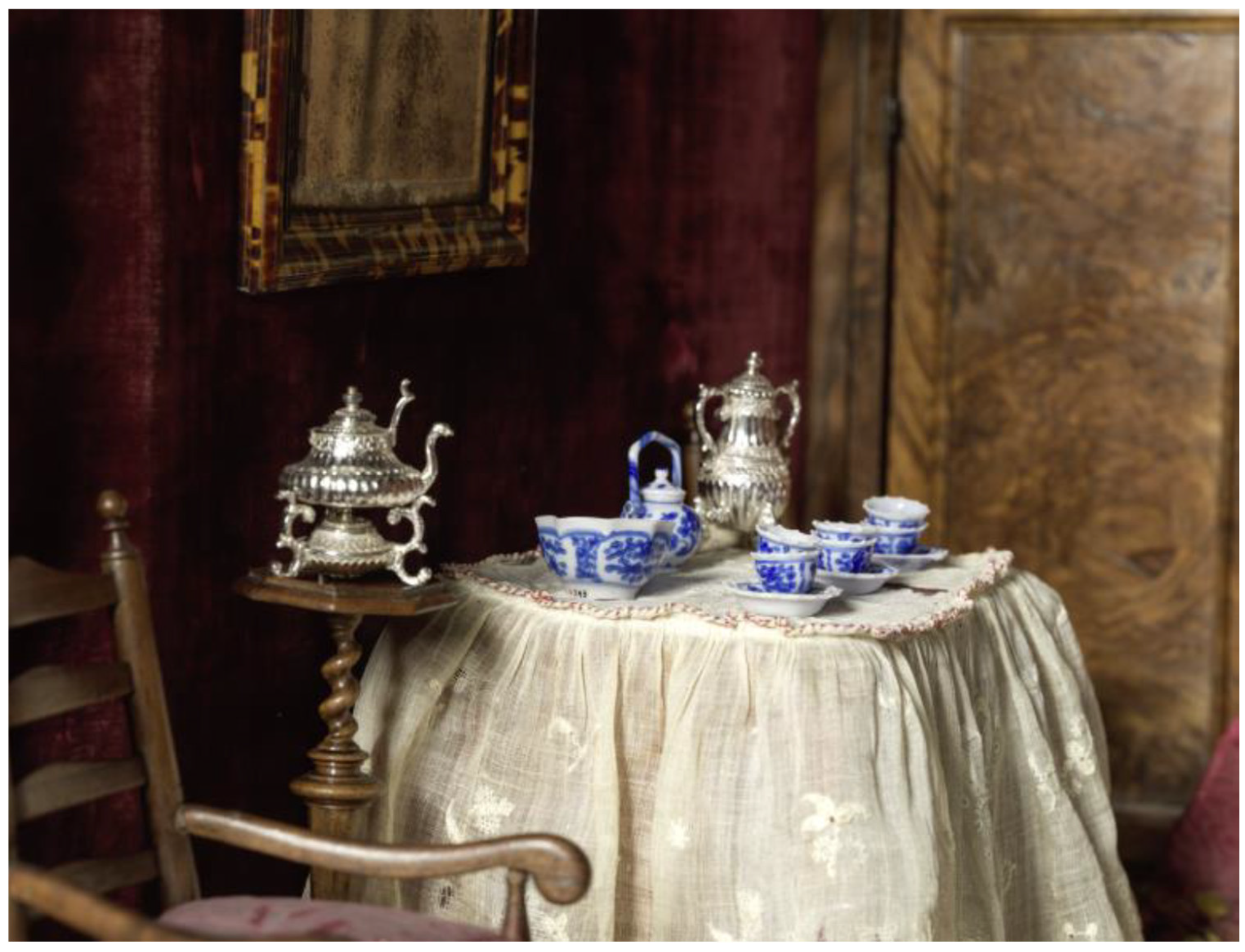

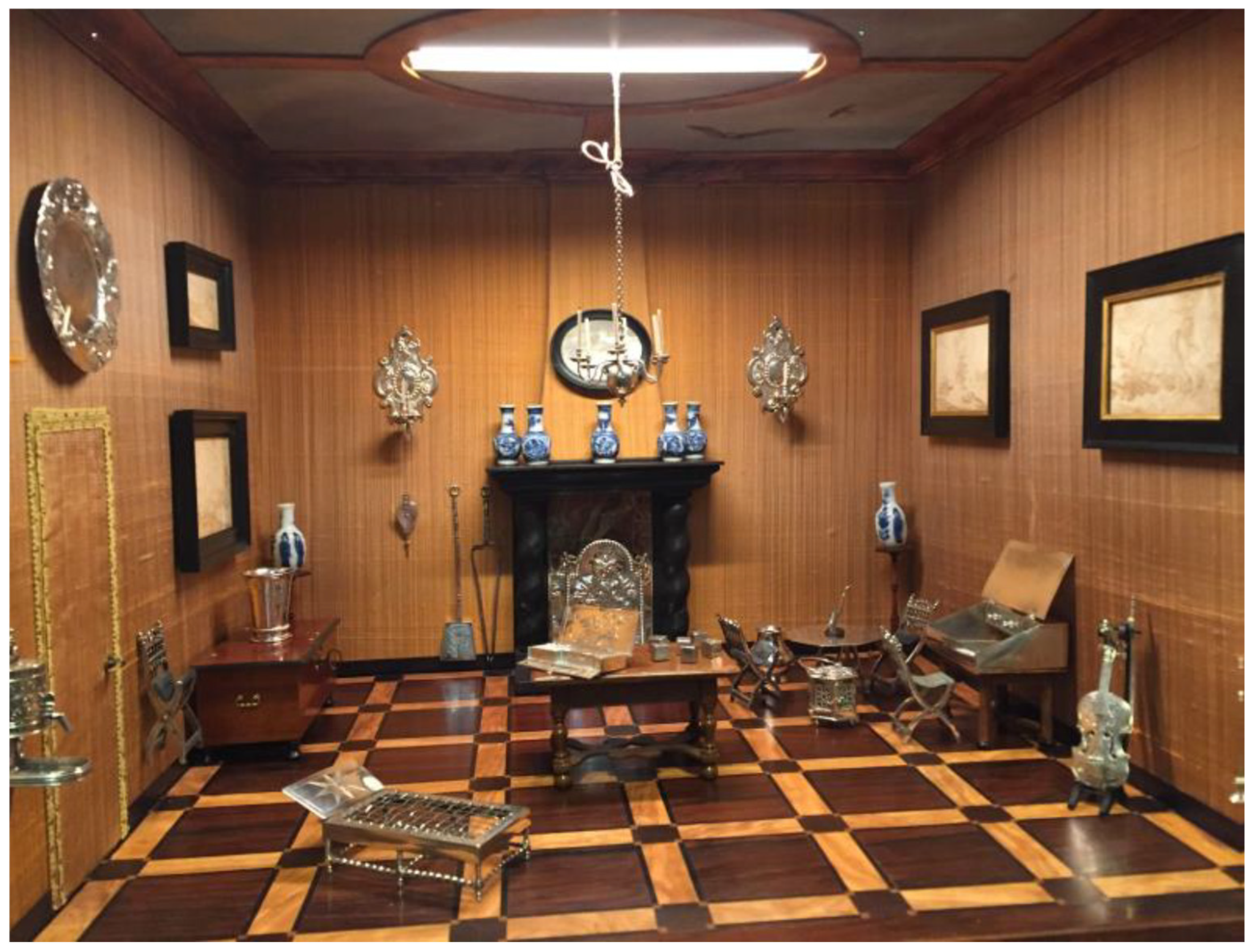
Disclaimer/Publisher’s Note: The statements, opinions and data contained in all publications are solely those of the individual author(s) and contributor(s) and not of MDPI and/or the editor(s). MDPI and/or the editor(s) disclaim responsibility for any injury to people or property resulting from any ideas, methods, instructions or products referred to in the content. |
© 2025 by the author. Licensee MDPI, Basel, Switzerland. This article is an open access article distributed under the terms and conditions of the Creative Commons Attribution (CC BY) license (https://creativecommons.org/licenses/by/4.0/).
Share and Cite
Moseley-Christian, M. The Material Culture of Seventeenth- and Eighteenth-Century Dutch Dollhouses: Replication, Reproduction & Imitation. Arts 2025, 14, 151. https://doi.org/10.3390/arts14060151
Moseley-Christian M. The Material Culture of Seventeenth- and Eighteenth-Century Dutch Dollhouses: Replication, Reproduction & Imitation. Arts. 2025; 14(6):151. https://doi.org/10.3390/arts14060151
Chicago/Turabian StyleMoseley-Christian, Michelle. 2025. "The Material Culture of Seventeenth- and Eighteenth-Century Dutch Dollhouses: Replication, Reproduction & Imitation" Arts 14, no. 6: 151. https://doi.org/10.3390/arts14060151
APA StyleMoseley-Christian, M. (2025). The Material Culture of Seventeenth- and Eighteenth-Century Dutch Dollhouses: Replication, Reproduction & Imitation. Arts, 14(6), 151. https://doi.org/10.3390/arts14060151





